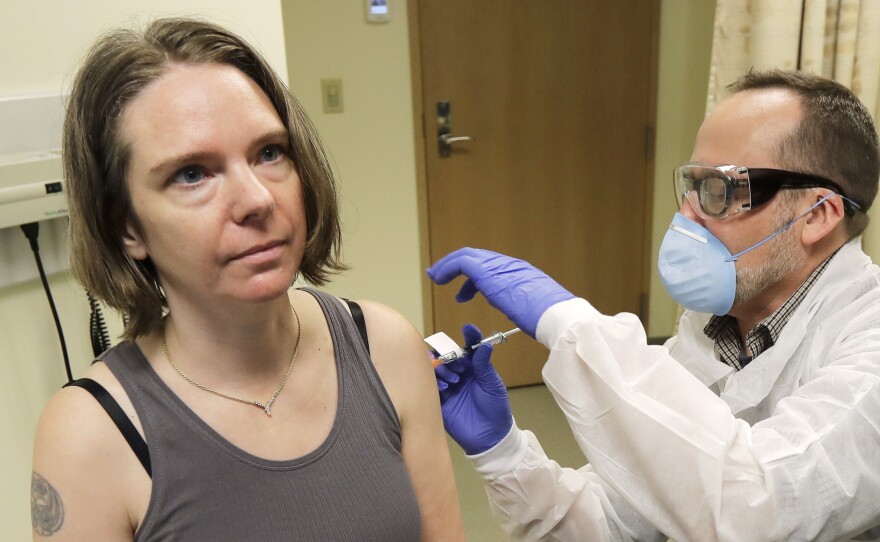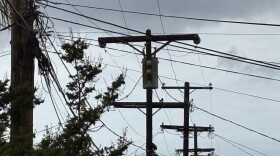It’s been just over a year since COVID-19 was officially declared a pandemic. A year of anxiety, hardship, confusion and loss. A year like no other. We were told, "We are all in this together," but some communities suffered more than others. Many people untouched by the virus itself were hurt by its fallout, seeing their businesses and jobs evaporate. Now, that there's a glimmer of light at the end of this long, dark tunnel. KPBS Midday Edition marked this anniversary Monday with a look back and a look forward.

Loss of family members, friends
The sheer number of people who have lost their lives to COVID-19 in the last year has been staggering. In San Diego County alone, nearly 3,500 have perished from a virus that has claimed the lives of over 56,000 statewide. So many people are grieving the loss of family members and friends, and yet the process is often a solitary one.
Jojo Riegel is the longtime partner of beloved San Diego blues musician Tomcat Courtney who died earlier this year due to complications from coronavirus. Courtney, a Texas transplant who was a fixture of the San Diego music scene for decades, met Riegel at one of his performances. The two became an inseparable team and she became his agent and backed him on the keyboard.
Riegel joined Midday Edition to share her story of loss and reflections on a year of change and tragedy.
Latino community hit hard by pandemic
Not all communities have been hit equally hard by the COVID-19 pandemic. In San Diego, a map and a list of zip codes tells the story. By far, the most coronavirus cases, serious illness and deaths have been in predominantly Latino neighborhoods. Latinos make up 34% of San Diego County residents but account for 44% of COVID-19 deaths and 55% of cases of the disease.
And the bulk of the jobs lost during the shutdown have been in the hospitality and service industries — occupied by a largely Latino workforce.
Dr. Christian Ramers, assistant medical director with Family Health Centers, is Cuban-American and works in many predominantly-Latino communities in San Diego County. He joined Midday Edition to discuss the reasons the Latino community had been hit hardest by the pandemic and what can be done going forward to help the community.

Dealing with the stress of COVID-19
Baking bread became a popular pastime for many during this pandemic year. It relieved boredom, made up for absent bakery goods and filled homes with a comforting aroma. But for some it became an anchor in the storm.
Author Marivi Soliven sometimes baked as she received calls from hospitals anxious to use her Tagalog Filipino interpreter skills to communicate with COVID-19 patients.
Soliven joined Midday Edition to talk about her experience as an interpreter for critically ill patients and how she comforted herself and others by baking.
How much learned
A year ago we didn’t even really know what to call the new virus that had already shut down an entire province in China. As it gained traction in the U.S., there were weeks of mixed messages on wearing masks, about wiping off packages and about how contagious or how deadly this virus was. It was the beginning of the learning curve on COVID-19 that is still keeping researchers and scientists busy one year later. Over these difficult months, much has been learned about the disease — information that has led to the creation of effective vaccines and new treatments. But this viral strain, and its host of effects on the human body, still has secrets to reveal.
Dr. Eric Topol, founder and director of the Scripps Research Translational Institute, joined Midday Edition to discuss the knowns and unknowns of coronavirus.
COVID-19 variants
As vaccination efforts against COVID-19 ramp up worldwide, transmission rates and hospitalizations seem to be trending downward. While this comes as good news to a beleaguered global health infrastructure, the issue of variant forms of COVID-19 continues to generate concern among health officials across the globe.
How do these mutated strains of COVID-19 pop up? And how do they complicate our efforts to fight the global pandemic?
Dr. Davey Smith, head of the Division of Infectious Diseases and Global Public Health at UC San Diego, joined Midday Edition to discuss what we know about COVID-19 variants.











